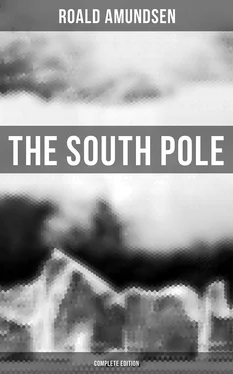On the 11th we made the interesting discovery that the Ross Barrier ended in an elevation on the south-east, formed between a chain of mountains running south-eastward from South Victoria Land and another chain on the opposite side, which runs south-westward in continuation of King Edward VII. Land.
On the 13th we reached lat. 84°, where we established a depot. On the 16th we got to 85°, where again we formed a depot. From our winter quarters at Framheim we had marched due south the whole time.
On November 17, in lat. 85°, we came to a spot where the land barrier intersected our route, though for the time being this did not cause us any difficulty. The barrier here rises in the form of a wave to a height of about 300 feet, and its limit is shown by a few large fissures. Here we established our main depot. We took supplies for sixty days on the sledges and left behind enough provisions for thirty days.
The land under which we now lay, and which we were to attack, looked perfectly impossible, with peaks along the barrier which rose to heights of from 2,000 to 10,000 feet. Farther south we saw more peaks, of 15,000 feet or higher.
Next day we began to climb. The first part of the work was easy, as the ground rose gradually with smooth snow-slopes below the mountain-side. Our dogs working well, it did not take us long to get over these slopes.
At the next point we met with some small, very steep glaciers, and here we had to harness twenty dogs to each sledge and take the four sledges in two journeys. Some places were so steep that it was difficult to use our ski. Several times we were compelled by deep crevasses to turn back.
On the first day we climbed 2,000 feet. The next day we crossed small glaciers, and camped at a height of 4,635 feet. On the third day we were obliged to descend the great Axel Heiberg Glacier, which separates the mountains of the coast from those farther south.
On the following day the longest part of our climbing began. Many detours had to be made to avoid broad fissures and open crevasses. Most of them were filled up, as in all probability the glacier had long ago ceased to move; but we had to be very careful, nevertheless, as we could never know the depth of snow that covered them. Our camp that night was in very picturesque surroundings, at a height of about 5,000 feet.
The glacier was here imprisoned between two mountains of 15,000 feet, which we named after Fridtjof Nansen and Don Pedro Christophersen.
At the bottom of the glacier we saw Ole Engelstad’s great snow-cone rising in the air to 19,000 feet. The glacier was much broken up in this narrow defile; enormous crevasses seemed as if they would stop our going farther, but fortunately it was not so bad as it looked.
Our dogs, which during the last few days had covered a distance of nearly 440 miles, put in a very good piece of work that day, as they did twenty-two miles on ground rising to 5,770 feet. It was an almost incredible record. It only took us four days from the barrier to reach the immense inland plateau. We camped at a height of 7,600 feet. Here we had to kill twenty-four of our brave dogs, keeping eighteen — six for each of our three sledges. We halted here for four days on account of bad weather. On November 25 we were tired of waiting, and started again. On the 26th we were overtaken by a raging blizzard. In the thick, driving snow we could see absolutely nothing; but we felt that, contrary to what we had expected — namely, a further ascent — we were going rapidly downhill. The hypsometer that day showed a descent of 600 feet. We continued our march next day in a strong wind and thick, driving snow. Our faces were badly frozen. There was no danger, but we simply could see nothing. Next day, according to our reckoning, we reached lat. 86°. The hypsometer showed a fall of 800 feet. The following day passed in the same way. The weather cleared up about noon, and there appeared to our astonished eyes a mighty mountain range to the east of us, and not far away. But the vision only lasted a moment, and then disappeared again in the driving snow. On the 29th the weather became calmer and the sun shone — a pleasant surprise. Our course lay over a great glacier, which ran in a southerly direction. On its eastern side was a chain of mountains running to the southeast. We had no view of its western part, as this was lost in a thick fog. At the foot of the Devil’s Glacier we established a depot in lat. 86° 21’, calculated for six days. The hypsometer showed 8,000 feet above sea level. On November 30 we began to ascend the glacier. The lower part was much broken up and dangerous, and the thin bridges of snow over the crevasses often broke under us. From our camp that evening we had a splendid view of the mountains to the east. Mount Helmer Hansen was the most remarkable of them all; it was 12,000 feet high, and covered by a glacier so rugged that in all probability it would have been impossible to find foothold on it. Here were also Mounts Oskar Wisting, Sverre Hassel, and Olav Bjaaland, grandly lighted up by the rays of the sun. In the distance, and only visible from time to time through the driving mists, we saw Mount Thorvald Nilsen, with peaks rising to 15,000 feet. We could only see those parts of them that lay nearest to us. It took us three days to get over the Devil’s Glacier, as the weather was unusually misty.
On December 1 we left the glacier in high spirits. It was cut up by innumerable crevasses and holes. We were now at a height of 9,370 feet. In the mist and driving snow it looked as if we had a frozen lake before us; but it proved to be a sloping plateau of ice, full of small blocks of ice. Our walk across this frozen lake was not pleasant. The ground under our feet was evidently hollow, and it sounded as if we were walking on empty barrels. First a man fell through, then a couple of dogs; but they got up again all right. We could not, of course, use our ski on this smooth-polished ice, but we got on fairly well with the sledges. We called this place the Devil’s Ballroom. This part of our march was the most unpleasant of the whole trip. On December 2 we reached our greatest elevation. According to the hypsometer and our aneroid barometer we were at a height of 11,075 feet — this was in lat. 87° 51’. On December 8 the bad weather came to an end, the sun shone on us once more, and we were able to take our observations again. It proved that the observations and our reckoning of the distance covered gave exactly the same result — namely, 88° 16’ S. lat. Before us lay an absolutely flat plateau, only broken by small crevices. In the afternoon we passed 88° 23’, Shackleton’s farthest south. We pitched our camp in 88° 25’, and established our last depot — No. 10. From 88° 25’ the plateau began to descend evenly and very slowly. We reached 88° 29’ on December 9. On December 10, 88° 56’; December 11, 89° 15’; December 12, 89° 30’; December 13, 89° 45’.
Up to this moment the observations and our reckoning had shown a surprising agreement. We reckoned that we should be at the Pole on December 14. On the afternoon of that day we had brilliant weather — a light wind from the south-east with a temperature of — 10° F. The sledges were going very well. The day passed without any occurrence worth mentioning, and at three o’clock in the afternoon we halted, as according to our reckoning we had reached our goal.
We all assembled about the Norwegian flag — a handsome silken flag — which we took and planted all together, and gave the immense plateau on which the Pole is situated the name of “King Haakon VII.‘s Plateau.”
It was a vast plain of the same character in every direction, mile after mile. During the afternoon we traversed the neighbourhood of the camp, and on the following day, as the weather was fine, we were occupied from six in the morning till seven in the evening in taking observations, which gave us 89° 55’ as the result. In order to take observations as near the Pole as possible, we went on, as near true south as we could, for the remaining 9 kilometres. On December 16 we pitched our camp in brilliant sunshine, with the best conditions for taking observations. Four of us took observations every hour of the day — twenty-four in all. The results of these will be submitted to the examination of experts.
Читать дальше












